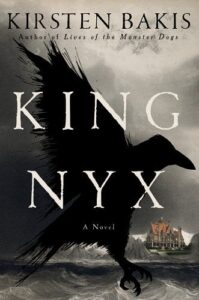
Writing Into Negative Space: Shining A Spotlight on History’s Sidelined Women
Kirsten Bakis Explores the Lives of Writer and Paranormalist Cult Figure Charles Fort and His Wife, Anna
“This woman cannot think, she feels.” An observation made in passing by Theodore Dreiser about the wife of a friend, Charles Fort; a casual summing-up by the famous novelist of a woman he considered of little importance.
I was reading about Fort—an unusual cult figure from the early twentieth century whose books have inspired countless UFO chasers, conspiracy theorists, and lovers of the unexplained ever since—because I thought he might be a character in the novel I was writing.
In the early part of the 20th century, he spent his days in public libraries, combing the archives of scientific and meteorological journals for reports of anomalous events—rains of blood and fish; mysterious floating lights; “a host of self-luminous bodies” spotted through an astronomer’s telescope.
I sensed Charles loved her, but also that he was often lost in his own thoughts.
His books are a catalog of unexplained events that lurk in the margins of history, all of them tantalizingly suggestive. Around the edges of the brief report of the Rev. W. Read, amateur astronomer, for example, a scene forms in my mind: The reverend leans in towards his telescope in his dark study in September of 1850, lips parting in silent amazement. The glowing objects are “round and sharply defined,” and there are so, so many. They don’t look the way he thought angels would, I imagine—he always pictured a flurry of wings—but they don’t look like anything else he’s ever seen, either. Maybe, he thinks—not without hope, even with longing—maybe they are angels.
It’s cold in the study. The vicarage is drafty; maybe small-town politics weigh on him. But for a time he’s taken away from them, lifted to another place beyond the edges of the known world, full of possibility.
To Charles, too, events such as this were suggestive, and he came up with many wackily poetic, nonsensical explanations for them. Red rain, he proposed, might be caused by “A thing the size of the Brooklyn Bridge. It’s alive in outer space—something the size of Central Park kills it—It drips.”
*
He told friends he didn’t believe any of his own hypotheses; but he didn’t believe those of actual scientists, either. His words often feel like an attempt to paper over a deep well of sadness and uncertainty. Underneath his jokey prose, I sense a lost quality, a yearning. I can imagine every one of his theories followed by “haha just kidding… unless…?”
He’s a character who tugs at my heartstrings, and I felt it especially as I read the account of the winter night in 1909 when Theodore Dreiser went looking for his friend Charles, whom he hadn’t seen in a year, and found him in a squalid tenement apartment in the New York neighborhood called Hell’s Kitchen.
As an editor at Smith’s Magazine, Dreiser had solicited short fiction and vignettes of city life from Charles, but they’d lost touch, and now Charles was in a squalid walkup with peeling paint and a back-alley view. The poor man looked unkempt and grimy that the famously gruff Dreiser was moved with pity and hugged him. Charles explained was working on a book he believed would be brilliant enough to save him from poverty.
He was alone that night: his wife Anna was out boarding in a hotel basement so that she could work long hot hours in its underground laundry, a notoriously hellish job. She was supporting Charles so he could write. Charles suggested Dreiser come back and have dinner with him—when Anna was there to cook it, of course. In reading, I sensed Charles loved her, but also that he was often lost in his own thoughts and left her to take care of many of his needs.
A week later, Dreiser returned to an apartment scrubbed clean, cheerful candles in the windows, food simmering on the stove. All Anna’s doing. Dreiser recorded in his notes that Charles was quiet that evening, though Dreiser was sure his friend’s mind was occupied with brilliant thoughts.
Anna, on the other hand, he saw as acting like a servant: bustling around, putting dishes on the table, chattering emptily about the wild birds she liked to feed. He believed she didn’t comprehend her husband’s ideas, only dimly aware that she was “part of something magnificent”—that is, Charles’s work. He summed up his impression of her that night with those six words that lodged in my mind: “This woman cannot think, she feels.”
Fort did not easily find the financial security he wanted. He got a novel published but it didn’t do very well, and when he attempted to interest editors in his new manuscripts, no one bit. Finally Dreiser, convinced of the importance of the work, cornered his own publisher, Boni & Liveright, home to the likes of Faulkner and Hemingway, threatening to leave unless they took on Fort’s 1919 The Book of the Damned.
Unwilling to lose Dreiser, they reluctantly produced 500 copies. But their publicist, pioneering propagandist Edward Bernays, gamely offered this selling point in early ads: “For Every Five People Who Read It Four Will Go Insane!”
I don’t know whether anyone lost their mind from reading his books, but they did often have strong reactions. In later years, when Dreiser sent Fort’s work to H.G. Wells, Wells replied that Charles was “one of the most damnable bores who ever cut scraps from out-of-the-way newspapers. And he writes like a drunkard,” he added, before noting that he tossed the book into the trash.
In spite of this, and in no small part thanks to Dreiser’s advocacy, Charles wound up doing all right for himself, publishing three more books in the same vein as The Book of the Damned and attracting a small group of devoted believers who created the Fortean Society, which he shyly allowed to celebrate him at its inaugural meeting.
What Anna thought of Charles’s work is not recorded. After her husband’s death, she sat for an interview with Theodore Dreiser in 1933 at Dreiser’s impressive country home in Mt. Kisco, New York. Dreiser wanted to write about Charles. Anna was reserved, saying no more than was necessary. At one point Dreiser commented that Charles had said sometimes “that he thought his whole life was wasted. I told him that was ridiculous.” Anna did not reply.
In the end, it was not Charles but Anna who took hold of my imagination.
Her real feelings, too, exist somewhere outside of what has been recorded, in the realm of the unknown. There are a few clues. In 1921, Charles wrote the novelist to say he and Anna had had “another fight.” Anna felt she could have been a great singer if she’d had a chance to try. Fort replied, “One damn genius in the family is too damn much.” He doesn’t record her response, but I can well imagine she agreed. She spent so much energy looking after Charles; when would she have time to be a genius? Besides, she didn’t have Theodore Dreiser going to bat for her.
Their argument was eventually drowned in beer. (Charles reported there were four bottles between them, then, “six…eight…nine black bottles on the table.”) They belted out a few songs, Charles delighting in their harmony. One was “On the Banks of the Wabash,” written by Dreiser’s brother, songwriter Paul Dresser. This gave Anna the idea that Charles should write to Dreiser. She got him pen and paper, resulting in the sloppy, beer-smudged letter now in the novelist’s archives.
In Dreiser’s account of the 1909 meeting and dinner, back when the Forts were still poor, I see a different picture from the one he did. I see Charles struggling with self-care in Anna’s absence, then, when his important guest arrives, sitting shy and tongue-tied. I hear Anna filling the silence with conversation about anything at hand, knowing how important Dreiser could be to their livelihood, and that he couldn’t be left to dine in awkward silence.
But whatever thoughts Anna really had that night were invisible to Dreiser, and now, over a hundred years later—like the thoughts of so many women who stood beyond the edges of the spotlight’s glow—they are lost to history.
In the end, it was not Charles but Anna who took hold of my imagination. Charles’s thoughts are cataloged in 800+ pages of his collected works. His mind, as much as anyone’s, is known territory. But Anna’s exists in the margins, hinted at in silences, in questions she declined to answer, in arguments she let go of so she could harmonize with her Charlie, their drunken voices rising together over the cluttered kitchen table.
Some of the phenomena Charles Fort recorded have since been explained, but many have not. In April 2023, for example, the Pentagon was reported to be examining 650 cases of unidentified flying objects—some saucer-shaped, or cigar-shaped. Some metallic, some pink and shining. Some luminous and round.
One more small fact I know about Anna is that later in life, when the couple had a bit of money, she acquired some pet birds and doted on them. I wonder if she still fed the wild ones outside, too, as she’d told Dreiser that day in 1909. I picture her standing on sunlit grass, tossing a handful of seeds high into the air. A flock of grateful sparrows materializes from somewhere—everywhere—trees, sky, earth. I see Anna lost in the fluttering cloud, obscured by a flurry of wings.
__________________________________

King Nyx by Kirsten Bakis is available from Liveright Publishing, an imprint of W.W. Norton & Company.
Kirsten Bakis
Kirsten Bakis teaches at the Yale Writers’ Workshop. Her previous novel, Lives of the Monster Dogs, was a New York Times Notable Book of the Year, winner of the Bram Stoker Award for best first novel, and was shortlisted for the international Women’s Prize for Fiction. She lives in New York's lower Hudson Valley.



















